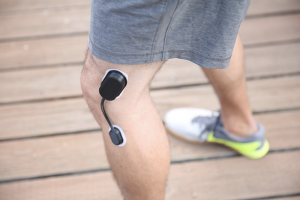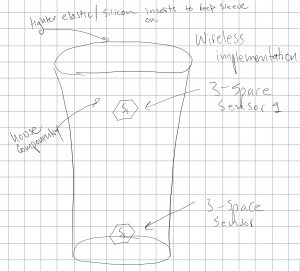SafeSleeve
Smart Active Flexion Extension Sleeve
By Jake Cordover
Description
The goal of SafeSleeve is to create a soft, functional knee sleeve that interfaces with a mobile device, reading back live data about knee motion, including flexion, extension, and hopefully excessive lateral translation. This type of device could benefit numerous individuals including, but not limited to: healthy athletes, rehabbing athletes, and rehabbing patients. Data about knee motions are readily available in a clinical setting, however most patients and athletes do not spend the majority of their recovery or activity in a clinical setting— by providing access to this data anywhere, patients can complete range of motion exercises within bounds set by their recovery team, coaches can assess positioning or form on movements, improving performance or enhancing safety, and motion extrema can be flagged, allowing for earlier injury detection. Additionally, providing a mechanism of injury could potentially lead to more accurate diagnoses.
To use SafeSleeve, a user would first put on the sleeve and turn it on with a switch or button. Depending on design implementation, the sleeve will require either consistent and precise positioning on the knee, or it will require a short calibration period. After the device has been positioned or calibrated, the user will open a companion application to select the mode of usage: either continuous live feedback, or sport mode. Live feedback would continuously display current knee metrics on a mobile device, while sport mode would keep all data on the sleeve, flag any data extrema, and transfer the data to a device at a later time. Finally, the data on the companion application can be analyzed in a number of ways like max extension/flexion/lateral translation, whether a set motion boundary was breached, and potentially how many reps of flexion/extension were performed in non-sport mode. The ability to track motion data over longer lengths of time may also be useful.
Similar Products
After perusing over similar, existing products, it was concluded that there is no other readily available functional knee sleeve that tracks positioning. However, two somewhat similar products were found, one of which was the Donjoy X4. This product differs in that it is a hard knee brace meant for post-operative knee arthroplasty. Hence, this product would not be suitable for athletes looking to track during activity— not to mention price. One of the benefits of the design of this project is if the planned design can be executed, sleeves can potentially fit under a number of braces, combining the benefits of the bracing stability, compression, and data. The other somewhat similar product is the Smart Knee, which is essentially two sensors connected by a bend sensor that attaches directly to the skin with adhesive pads. One, like the Donjoy, two sensors attached directly to the skin would not be optimal for athletes wanting a functional solution, and two the product does not appear to be sold to directly to consumers, and the cost for developer kits start at $2500. See below for images of the Donjoy X4 and the Smart Knee.

The smart knee is pictured above.

DonJoy X4 pictured above.
Sketches of Sleeve



Implementation and Materials
At this point, there are two potential implementations to make this product a reality. The first implementation involves using IMUs (inertial measurement units) or other wireless sensors. These sensors would be utilized with mathematics in order to provide the desired data. The benefits of going this route would nullify the necessity of precise and consistent sleeve placement. The disadvantages of going this route includes price, reliability and accuracy of sensors, and fairly sophisticated mathematical prerequisite knowledge required to achieve the data. For simplicity, this will be called the wireless implementation.
The other implementation involves utilizing a material that changes resistance, such as a flex senor, stretch sensor, stretchy conductive fabric, or conductive thread, and mapping the data to a known set of values to achieve the knee data. The benefits of this implementation include less involved knowledge of mathematics and a less expensive approach. However, there is concern about the durability of such materials holding up in strenuous activity and achieving and maintaining the exact fit of the sleeve from which the mapped values were accrued. Additionally, while maybe not a concern for this project, any future sleeves produced will need to be calibrated with a goniometer to each particular user. This implementation will be called the wired implementation.
The following materials will be required regardless of implementation:
- A knee sleeve ($15.48, amazon)
- Thread to stich down electronics
- Mobile device to capture data
The following materials would be necessary for the wireless implementation:
- (2X) Yost Labs 3-Space Mini Bluetooth sensors($65) or (2x) 3-Space Nano IC($12.50)
- If mini Bluetooth sensors not used,(37.50) 3-Space Nano Evaluation kitand Bluetooth module with batteries and wiring
- Either excess material to make a pocket for sensors or 3D printing to make housing for electronics to be sewn down to sleeve
The following materials would be necessary for the wired implementation:
- Small microcontroller like ($8.95) Trinket M0
- Batteries
- Either stretch conductive fabric/flex sensors/stretch sensors/conductive thread
- Either excess material to make a pocket or 3D printing to make housing for electronics to be sewn down to sleeve
Skills to be mastered
- Mathematical knowledge for wireless implementation
- Neat, elegant sewing
- 3D printing to house electronics
- If mini Bluetooth sensors not used, electrical/physical componentry and component communication protocols like I2C
- Measuring knee angles with goniometer for calibration/comparison
Timeline
- By March 11th: decide implementation plan and order materials needed
- By March 18th: have all materials on hand (pending shipping) and be able to collect some type of data on mobile device
- By March 25th: demonstrate that sensors provide a means of accurate knee data
- By April 1st: complete final design plan and produce 3d componentry if that route used
- By April 8th: demonstrate that sensor suite, perhaps temporarily integrated, produces accurate knee data
- By April 15th: push to complete integration and mobile app
- By April 22nd: Debug, finish app, demonstrate integrated knee sleeve works
Fallback Plan
If it is deemed too difficult to gather accurate, consistent knee data, strategic placement of soft switches on the knee sleeve could provide tactile feedback (vibration) if undesirable knee positions are realized.
Bare Minimal Outcome
The bare minimum for this project is to create a functional knee sleeve that provides some sort of feedback (data or tactile feedback) to a user. For how big of a field medical technology is, there are surprisingly few solutions to provide feedback on knee movement outside of a clinical setting. Thus, the inspiration of this project, and what will determine the success of the project is creating a functional knee sleeve, granting insights into knee metrics that are traditionally restricted to a clinical setting.
